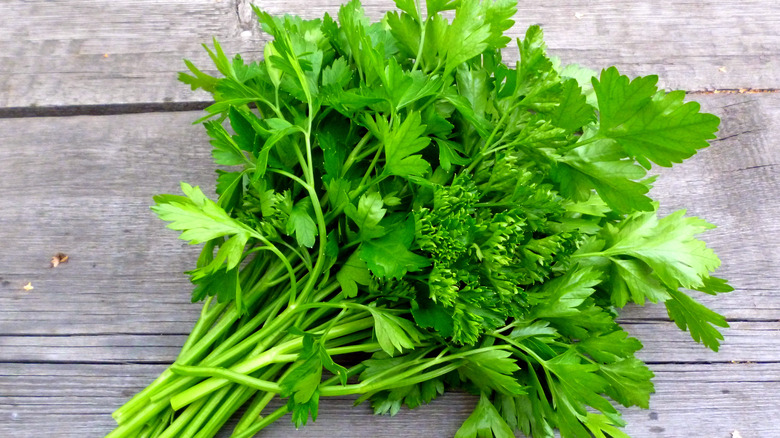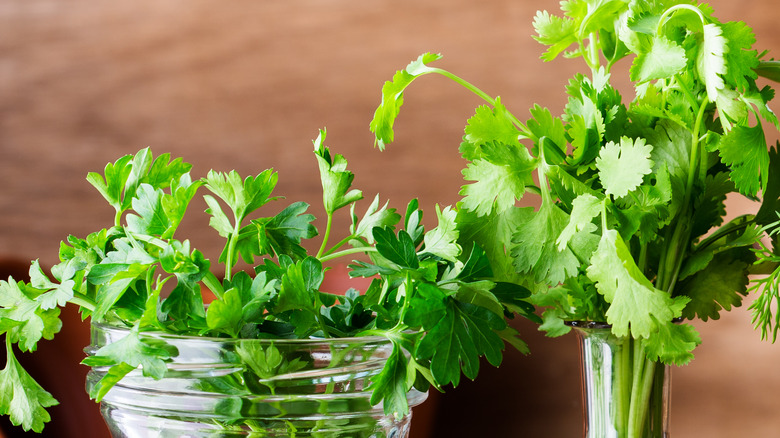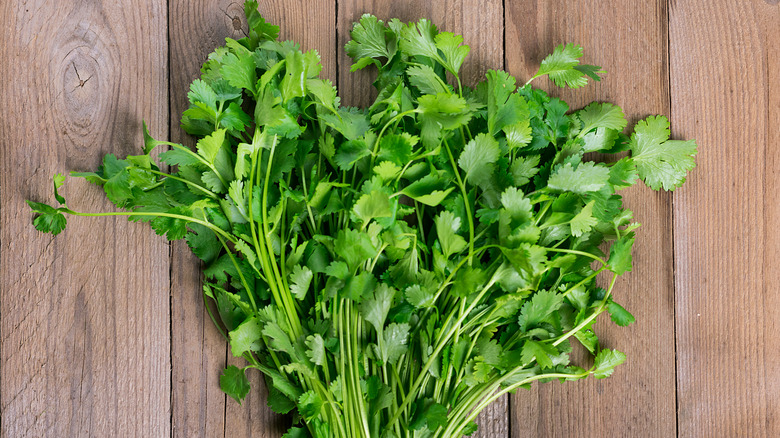Parsley Vs Cilantro: How To Choose Between Them
We may receive a commission on purchases made from links.
If you've ever come home with a grocery bag of goodies ready to make guacamole, only to realize you grabbed parsley instead of cilantro, we can relate. Is it just us, or do they purposefully place these two herbs right next to each other on the shelf, hoping we'll have to make a second trip to the store? When it comes to parsley and cilantro, they may look alike at first glance, but don't let looks fool you. They taste quite different, and you'll want to take a few extra seconds to make sure you're grabbing the right one.
According to Spoon University, while both parsley and cilantro are green herbs with long, skinny stalks and flat leaves, cilantro's leaves are a bit more rounded while parsley's are more like your archenemy's remarks: pointed. Better yet, there's even an easy way to remember this: use the "c" in cilantro to remind you its leaves are curved, and the "p" in parsley to prompt your memory that this plant's leaves are pointed. Taste Essence points out that parsley is also a darker green than cilantro.
Even more telling are the herbs' smell and taste.
Parsley and cilantro don't smell or taste alike
Cilantro, also known as coriander, Chinese parsley, and Mexican parsley (via MasterClass), has a distinct smell and taste that is "almost metallic," according to Spoon University. Interestingly, some people seem to experience the taste of cilantro in a different way than others, and not a good one! According to Britannica, some people have a variation in their "olfactory-receptor genes" that enables them to strongly perceive the aldehydes, or chemical compounds, present in cilantro leaves, making for a soapy taste. And tasting soap is not fun — just ask Ralphie Parker!
Parsley, on the other hand, gives off a mild, grassy smell and taste, according to Taste Essence. The outlet describes the smell as "more pungent" than the smell of cilantro. While flat-leaved parsley has a robust, peppery taste that isn't as strong as that of cilantro, according to the outlet, curly parsley is an entirely different story. It's bland and only used for decoration, not unlike some of our previous dinner dates (We kid!).
While the two might not be interchangeable in all recipes, don't throw your purchase out if you grabbed the wrong one. Both parsley and cilantro have plenty of uses!
Cooking with (and eating!) parsley and cilantro
Cilantro's flavor can be enjoyed in myriad recipes and can be found in Asian, Mexican, Middle Eastern, Indian, and Caribbean dishes (via Tasty Bite). It makes an appearance in guacamole, Indian chutneys, soups, and rice dishes (via Spoon University). All of the plant, including the leaves, roots, and stems are used in cooking, and according to Spiceography, cilantro appears in raw form in recipes like ceviche and pico de gallo.
If you're cooking with parsley, on the other hand, you'll typically only be using the leaves (via Spoon University). According to the outlet, parsley appears in Middle Eastern cooking in recipes like tabbouleh as well as in dishes like chimichurri sauce and pasta. But, the SeattleTimes points out that you can really put chopped parsley on just about anything and recommends freely using big pieces to top dishes like grilled vegetables, roasted potatoes, and green-bean salads. Ain't no party like a parsley party — it's like herb confetti!
Two healthy herbs
Parsley and cilantro share an impressive list of health benefits, according to some health experts. Dietician and nutritionist Patricia Bannan explained to Well + Good that both herbs contain vitamins A (an antioxidant good for eye and bone health), C (also an antioxidant and good for immunity), and K (good for bone health and healing). Both herbs also play a role in balancing blood sugar, according to dietitian Jenny Beth Kroplin (via Well + Good).
The splendid herbs also have some benefits all their own. Cilantro contains agents that help fight inflammation and soothe skin, according to Kroplin, and it has even been shown to have detoxifying, antibacterial, and cholesterol-lowering effects (via Well + Good). The outlet explains that parsley, on the other hand, can help ease bloating as well as aid in digestion, and the herb contains 5% of your daily iron per serving, according to Kroplin.
Honestly, you had us at ceviche and pasta, but we're even happier to indulge in these leafy herbs for good health's sake!



